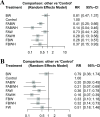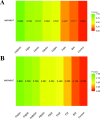Comparing warming strategies to reduce hypothermia and shivering in elderly abdominal or pelvic surgery patients: a network meta-analysis
- PMID: 40595941
- PMCID: PMC12216274
- DOI: 10.1038/s41598-025-04644-7
Comparing warming strategies to reduce hypothermia and shivering in elderly abdominal or pelvic surgery patients: a network meta-analysis
Abstract
Perioperative hypothermia (PHT) and shivering represent significant clinical challenges in geriatric surgical populations. This network meta-analysis (NMA) systematically evaluates the comparative efficacy of various warming interventions in preventing PHT and shivering among elderly patients undergoing abdominal or pelvic surgery. We conducted a comprehensive literature search across PubMed, EMBASE, Cochrane library, and China Wanfang databases for randomized controlled trials (RCTs) published up to April 2024. Inclusion criteria encompassed RCTs comparing warming strategies in patients aged ≥ 60 years undergoing abdominal or pelvic surgery. Methodological quality was assessed using the Cochrane Risk of Bias tool 2.0. Primary outcomes included incidence rates of PHT and shivering. A frequentist approach to NMA was performed using random-effects models, with surface under the cumulative ranking curve (SUCRA) values calculated for treatment ranking. The analysis incorporated 18 RCTs (n = 2161) evaluating eight distinct warming strategies. Network meta-analysis revealed that forced-air warming with blankets at ≥ 40 °C (FABWH) demonstrated superior efficacy for PHT prevention, while forced-air warming at ≥ 40 °C (FAWH) showed optimal performance for shivering reduction. Compared to standard care, FABWH significantly reduced PHT risk (RR = 0.14, 95% CI 0.04-0.46; P = 0.0012) and shivering incidence (RR = 0.21, 95% CI 0.07-0.69; P = 0.008). FAWH exhibited comparable effectiveness, with risk reductions of 72% for PHT (RR = 0.28, 95% CI 0.13-0.58; P = 0.0006) and 84% for shivering (RR = 0.16, 95% CI 0.07-0.39; P < 0.001). This NMA provides robust evidence that active warming strategies, particularly FABWH and FAWH, significantly mitigate PHT and shivering risks in elderly surgical patients. Future research should focus on long-term outcomes and cost-effectiveness analyses to optimize clinical decision-making.
Keywords: Abdominal or pelvic surgery; Electrically; Hypothermia; Meta-analysis; Warming strategy.
© 2025. The Author(s).
Conflict of interest statement
Declarations. Competing interests: The authors declare no competing interests. Ethical approval and informed consent: This study did not involve direct interaction with human subjects or collection of individual patient data, and therefore did not require ethical approval and informed consent statements.
Figures




Similar articles
-
Active body surface warming systems for preventing complications caused by inadvertent perioperative hypothermia in adults.Cochrane Database Syst Rev. 2016 Apr 21;4(4):CD009016. doi: 10.1002/14651858.CD009016.pub2. Cochrane Database Syst Rev. 2016. PMID: 27098439 Free PMC article.
-
Systemic pharmacological treatments for chronic plaque psoriasis: a network meta-analysis.Cochrane Database Syst Rev. 2021 Apr 19;4(4):CD011535. doi: 10.1002/14651858.CD011535.pub4. Cochrane Database Syst Rev. 2021. Update in: Cochrane Database Syst Rev. 2022 May 23;5:CD011535. doi: 10.1002/14651858.CD011535.pub5. PMID: 33871055 Free PMC article. Updated.
-
Systemic pharmacological treatments for chronic plaque psoriasis: a network meta-analysis.Cochrane Database Syst Rev. 2017 Dec 22;12(12):CD011535. doi: 10.1002/14651858.CD011535.pub2. Cochrane Database Syst Rev. 2017. Update in: Cochrane Database Syst Rev. 2020 Jan 9;1:CD011535. doi: 10.1002/14651858.CD011535.pub3. PMID: 29271481 Free PMC article. Updated.
-
Comparative effects of warming systems applied to different parts of the body on hypothermia in adults undergoing abdominal surgery: A systematic review and network meta-analysis of randomized controlled trials.J Clin Anesth. 2023 Oct;89:111190. doi: 10.1016/j.jclinane.2023.111190. Epub 2023 Jun 28. J Clin Anesth. 2023. PMID: 37390588
-
Drugs for preventing postoperative nausea and vomiting in adults after general anaesthesia: a network meta-analysis.Cochrane Database Syst Rev. 2020 Oct 19;10(10):CD012859. doi: 10.1002/14651858.CD012859.pub2. Cochrane Database Syst Rev. 2020. PMID: 33075160 Free PMC article.
References
-
- Jiang, Y. et al. Perioperative hypothermia in elderly patients during pelvic floor reconstruction surgery: An observational study. Int. Urogynecol. J.35, 1163–1170. 10.1007/s00192-024-05781-9 (2024). - PubMed
-
- Baucom, R. B. et al. Association of perioperative hypothermia during colectomy with surgical site infection. JAMA Surg.150, 570–575. 10.1001/jamasurg.2015.77 (2015). - PubMed
-
- Beilin, B. et al. Effects of mild perioperative hypothermia on cellular immune responses. Anesthesiology89, 1133–1140. 10.1097/00000542-199811000-00013 (1998). - PubMed
Publication types
MeSH terms
LinkOut - more resources
Full Text Sources
Medical
Miscellaneous

